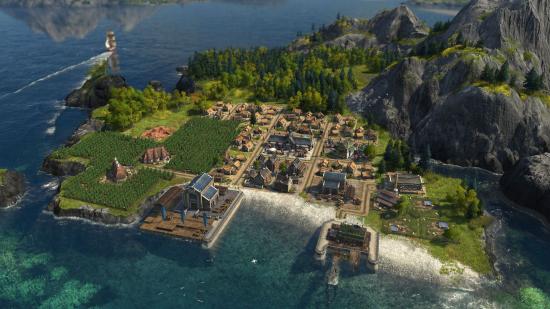Getting to grips with steel beams and weapon production in Anno 1800? For the most part, the production of resources in Anno 1800 is fairly straightforward and works like you might expect. A lumberjack hut gathers wood and delivers it to the sawmill where it’s turned into timber, for instance. Or a sheep farm gathers wool and sends it to the framework knitters to be turned into clothing.
These basic production chains tend to adhere to the 1:1 ratio rule of one resource gathering building to one resource refinement building. This can be gleaned from viewing the production time on any given building. In the above example, a lumberjack hut takes 15 seconds to gather wood, and a sawmill takes 15 seconds to turn that wood into timber. Thus, you’ll need one sawmill to every one lumberjack hut in order to most efficiently produce timber.
Unfortunately, that simple math will not always offer you a solution, so here’s what you need to produce steel beams and weapons in Anno 1800:
Producing steel beams, which is required for many mid- and late-game buildings and ships, requires four buildings: the iron mine, charcoal kiln, furnace, and steelworks. If you’re looking to make weapons, you’ll skip the steelworks and use a weapons factory instead. Looking at each building’s production times reveals that reaching optimum output is not as simple as building at a 1:1 ratio: the iron mine produces one unit of iron in 15 seconds, and the charcoal kiln produces one unit of coal in 30 seconds. The furnace takes those two raw materials and smelts them together, producing one unit of steel in 30 seconds. That steel then moves to the steelworks where, after 45 seconds, it’s turned into a steel beam, or to the weapons factory where, in 1 minute and 30 seconds, it will be turned into a unit of weapons.
Since the raw materials (iron and coal) are independent of one another, it can be tricky to decide on how many of each building you’ll need. Some quick math gives us the answer, though: an iron mine takes 15 seconds to make one iron, and a charcoal kiln takes double that to make one coal. Since you’re producing one iron in half the time it takes for a kiln to make coal, it makes sense to have two kilns per one mine. So, to start the chain, build two charcoal kilns per one iron mine. Simple.
As an alternative, a coal mine can be used in place of the two charcoal kilns. That’s not always possible, but coal mines produce coal in 15 seconds, which is twice as efficient as the kilns. This is dependent on the randomness of your island’s layout and access to resources, however.
Whatever the case, we can now move on to the furnace, where the coal and iron will be smelted into steel. The furnace takes 30 seconds to make one unit of steel, which is how long it takes the kilns to operate. Since there’s no way to speed up this process, and we’re producing 2 iron for every 1 coal, a 1:1 ratio of furnaces and kilns will do just fine. So, at this point, we have: one iron mine, two charcoal kilns, and two furnaces. Make sense so far? Good.
While you’re here: Check out the best building games on PC
Here’s where things go off the rails a little. The steelworks, which will take the steel from the furnace, requires 45 seconds to operate. Since none of the previous buildings in the chain operate at 45 seconds there’s not really any way to achieve a nice, round number when it comes to steel beam production. The closest we can get is to produce 1.3 steel beams per minute, which is done by building three steelwork buildings.
If you’re making weapons, though, you’ll need to build a whopping six factories to hit that optimum production line thanks to the longer build time. So, all told, we have the following production chains. For steel beams:
1 iron mine + 2 charcoal kilns/1 coal mine > 2 furnaces > 3 steelworks
And for weapons:
1 iron mine + 2 charcoal kilns/1 coal mine > 2 furnaces > 6 weapons factories
It’s unfortunate that Anno 1800 doesn’t do that great a job of helping players navigate some of the more complex production chains, but in that way the game facilitates experimentation. Hopefully this guide provides a useful augmentation to your city building adventures.


